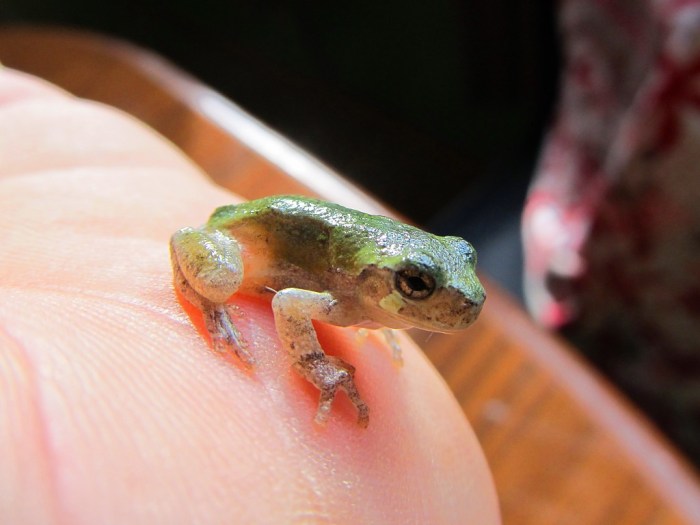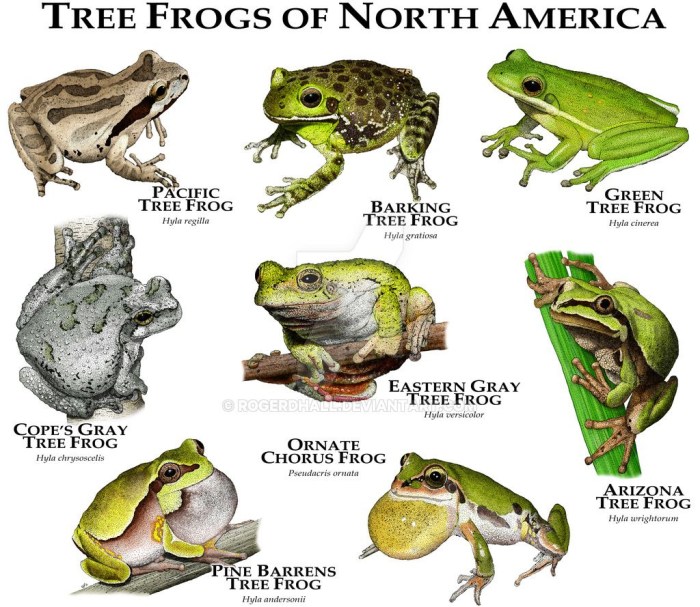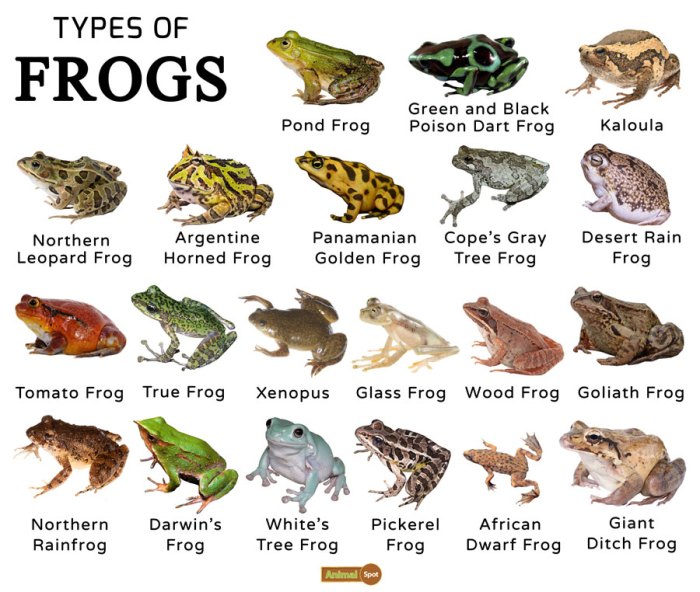Types of frogs in Ohio offer a fascinating glimpse into the state’s rich biodiversity. From native species to introduced ones, these amphibians play a vital role in the ecosystem. Join us as we explore the diverse world of frogs in Ohio, uncovering their unique characteristics, habitats, and significance.
Native frogs of Ohio include the American bullfrog, green frog, and wood frog, each with distinct size, color, and habitat preferences. Introduced species, such as the pickerel frog, have also found a home in Ohio, impacting native frog populations.
Native Frogs of Ohio

Ohio, a state in the Midwestern region of the United States, is home to a diverse array of native frog species. These amphibians inhabit various habitats, ranging from wetlands and ponds to forests and meadows, contributing to the ecological balance of the region.
The native frogs of Ohio exhibit a variety of unique characteristics, including distinctive coloration, size variations, and specific habitat preferences. Understanding these characteristics can help us appreciate the biodiversity of Ohio’s amphibian population.
Common Frogs
- Bullfrog(Lithobates catesbeianus): The largest frog in North America, known for its deep, resonating call. Adults can reach a length of up to 8 inches and have a green or brown coloration with dark blotches.
- Green Frog(Lithobates clamitans): A medium-sized frog with a bright green coloration and dark blotches. They prefer permanent bodies of water and are often found near marshes, ponds, and streams.
- Pickerel Frog(Lithobates palustris): A small frog with a brown or olive coloration and a dark stripe running down its back. They inhabit temporary pools and wetlands and are known for their distinctive “peep” call.
Introduced Frog Species: Types Of Frogs In Ohio

Ohio is home to a diverse array of native frog species. However, over the years, several non-native frog species have also been introduced to the state, primarily through the pet trade and unintentional releases.
The introduction of non-native species can have significant impacts on native ecosystems, including competition for resources, habitat alteration, and the transmission of diseases. In the case of frogs, introduced species can also pose a threat to native frog populations by preying on them or competing for food and breeding sites.
Ohio is home to a diverse range of frog species, from the tiny spring peeper to the larger bullfrog. While we’re on the topic of exams, have you heard about the nys sbl exam pass rate ? It’s an interesting statistic that shows the percentage of students who pass the New York State School Business Leader exam.
Back to our frogs, Ohio’s diverse frog population plays a vital role in the state’s ecosystem, controlling insect populations and providing food for other animals.
Bullfrog (Lithobates catesbeianus)
The bullfrog is one of the most common introduced frog species in Ohio. It was originally native to the eastern United States but has been widely introduced to other regions, including Ohio. Bullfrogs are large, opportunistic predators that can consume a variety of prey, including insects, fish, and even other frogs.
Did you know that Ohio is home to a diverse array of frog species? From the tiny spring peeper to the massive bullfrog, there’s a frog for every taste. Speaking of taste, have you heard about the “Queen of the South OEs”? This delightful treat is a must-try for any foodie.
But let’s not forget our frogs! Ohio’s frog population is a testament to the state’s rich biodiversity, and it’s a joy to observe these fascinating creatures in their natural habitat.
The introduction of bullfrogs to Ohio has had a number of negative impacts on native frog populations. Bullfrogs compete with native frogs for food and breeding sites, and they can also prey on native frog eggs and tadpoles. As a result, bullfrogs have contributed to the decline of several native frog species in Ohio.
Green Frog (Lithobates clamitans), Types of frogs in ohio
The green frog is another introduced frog species that is common in Ohio. It is native to the eastern United States and has been introduced to a number of other regions, including Ohio. Green frogs are medium-sized frogs that are typically green in color with dark spots.
They are found in a variety of habitats, including ponds, marshes, and streams.
The introduction of green frogs to Ohio has had a less significant impact on native frog populations than the introduction of bullfrogs. However, green frogs do compete with native frogs for food and breeding sites, and they can also prey on native frog eggs and tadpoles.
When you’re out exploring the diverse types of frogs in Ohio, you may work up an appetite. If you’re looking for a satisfying and authentic Cuban meal, be sure to check out pan cubano cerca de mi . This delicious sandwich is a staple of Cuban cuisine and is sure to hit the spot after a day of frog spotting.
As a result, green frogs have contributed to the decline of some native frog species in Ohio.
Frog Habitats in Ohio

Ohio’s diverse landscape provides a range of habitats suitable for frogs, each offering unique resources that support their survival and reproduction.
Wetlands, such as marshes, swamps, and bogs, are crucial for many frog species. These areas provide ample water for breeding, as well as vegetation for shelter and food. Forests, both deciduous and coniferous, offer moist microclimates, fallen logs for cover, and abundant insect prey.
Grasslands, including prairies and meadows, provide open areas for foraging and breeding, as well as temporary pools during heavy rainfall.
Wetlands
- Provide breeding grounds with ample water
- Offer vegetation for shelter and egg-laying sites
- Support diverse aquatic plant and animal life, serving as a food source
Forests
- Maintain moist microclimates, essential for frog respiration and skin health
- Provide fallen logs and leaf litter for shelter and protection
- Host a variety of insects and other invertebrates, serving as a food source
Grasslands
- Offer open areas for foraging and basking
- Provide temporary pools during heavy rainfall, suitable for breeding
- Support diverse plant life, attracting insects and other prey
Threats to Frogs in Ohio

Frogs in Ohio face various threats that impact their populations and overall well-being. These threats include habitat loss, pollution, and climate change.Habitat loss occurs when natural frog habitats, such as wetlands, ponds, and forests, are converted for other uses, such as development, agriculture, or mining.
This loss of habitat reduces the available breeding and feeding grounds for frogs, leading to population decline.Pollution from sources such as agricultural runoff, industrial discharge, and stormwater can contaminate waterways and soil, harming frogs and their tadpoles. Pesticides and herbicides used in agriculture can kill frogs directly or indirectly by affecting their food sources.Climate
change poses a threat to frogs through changes in temperature, precipitation patterns, and extreme weather events. These changes can disrupt frog breeding cycles, reduce their food availability, and make them more vulnerable to disease.
Conservation Measures
To address these threats, conservation measures are crucial to protect frog populations in Ohio. These measures include:
- Protecting and restoring frog habitats through land acquisition, conservation easements, and habitat management.
- Reducing pollution by implementing best management practices in agriculture, industry, and stormwater management.
- Monitoring frog populations and conducting research to understand the impacts of threats and develop effective conservation strategies.
- Educating the public about the importance of frogs and the threats they face to foster support for conservation efforts.
By implementing these conservation measures, we can help ensure the survival of frog populations in Ohio and maintain the ecological balance of our ecosystems.
Importance of Frogs in the Ecosystem

Frogs play a vital role in maintaining the balance and health of ecosystems in Ohio. As predators, they help control populations of insects and other invertebrates, reducing the risk of outbreaks that could damage vegetation and disrupt food chains. Conversely, as prey, frogs are a crucial food source for various animals, including snakes, birds, and mammals, supporting higher trophic levels and contributing to the overall biodiversity of the ecosystem.
Indicators of Environmental Health
Frogs are highly sensitive to environmental changes, making them valuable indicators of ecosystem health. Their presence or absence, abundance, and reproductive success can provide insights into the quality of water, air, and soil in a given area. Monitoring frog populations can help identify pollution, habitat degradation, and other environmental stressors, allowing for timely intervention and conservation efforts to protect the ecosystem and human health.
Contributors to Biodiversity and Stability
The presence of diverse frog species enhances the overall biodiversity of Ohio’s ecosystems. Each species occupies a unique niche, contributing to the stability and resilience of the ecosystem. Frogs play a crucial role in nutrient cycling, seed dispersal, and pollination, contributing to the overall health and productivity of the environment.
By maintaining healthy frog populations, we ensure the long-term sustainability and resilience of Ohio’s ecosystems.
User Queries
What is the most common frog in Ohio?
The American bullfrog is the most common frog species found throughout Ohio.
What is the smallest frog in Ohio?
The spring peeper is the smallest frog species in Ohio, measuring only about 1 inch in length.
Are there any poisonous frogs in Ohio?
No, there are no poisonous frog species native to Ohio.